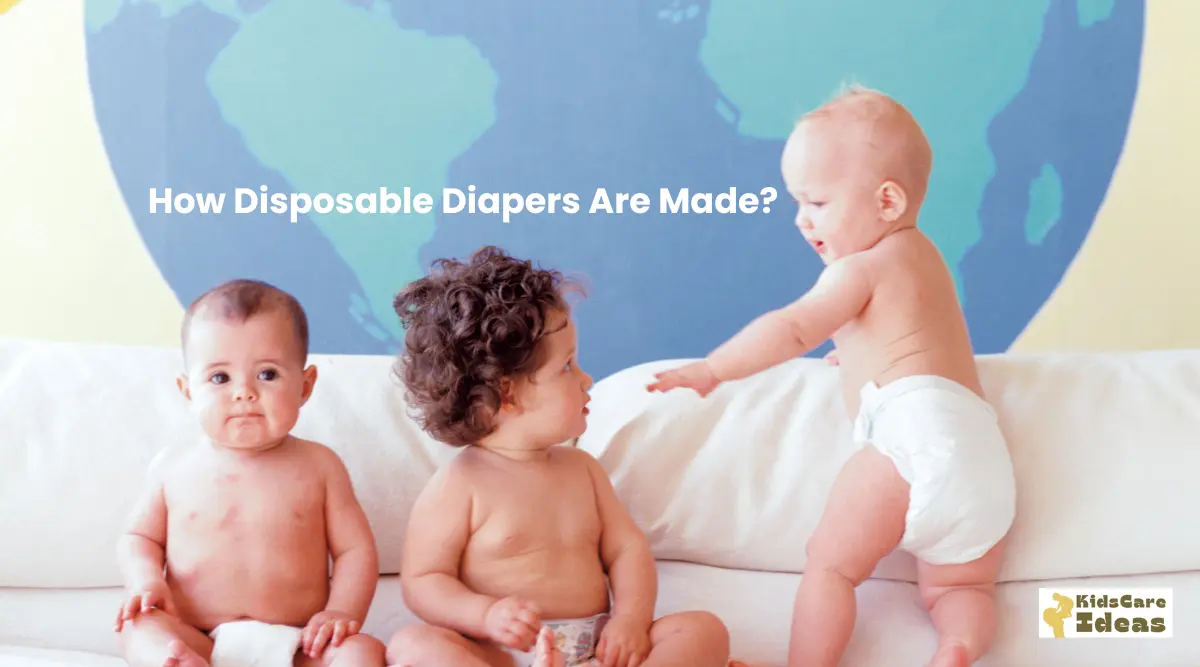Ever wondered how disposable diapers are made? In this article, we’ll break down the entire manufacturing process and talk about the materials used.

Let’s jump in!
Manufacturing Process (Step by Step)
The entire process of diaper manufacture can be divided into three primary steps:
- Forming the Absorbent Pad
- Creating the Non-Woven impermeable sheet
- Assembling the Components
Step #1: Forming the Absorbent Pad:
- The absorbent pad is formed by the use of a vacuum.
- A conveyor belt passes the absorbent material on the surface.
- Through various machine parts, the thickness and surface of the absorbent pad is made smooth and uniform.
Step #2: Creating the Non-Woven impermeable sheet
- The impermeable top and bottom sheets are formed next.
- The non-woven plastic sheets are formed by the meltdown process.
- Stretched elastic bands are also used for backing the sheet’s adhesive and also to create a snug fit that will possibly prevent leakage.
These layers should be preferably ultra soft and capable of wicking away moisture from the baby’s skin.
Step #3: Assembling the Components:
- Once the three components that are absorbent pad, topsheet, and bottom sheet are individually in place, it is glued or compiled together ultrasonically.
- Usually, the final product comes out in long rolls and strips which are then made into individual units.
Raw Materials Used in Disposable Diaper Manufacturing
The primary raw materials used for manufacturing disposable diapers are:
- Polyethylene
- Polypropylene
- Cellulose
- Super Absorbent polymer
- Elastic
- Adhesive
- Tapes
Almost every disposable diaper has a similar constitution – an absorbent pad sandwiched between non-woven fabrics. The pad absorbs and retains the body fluid.
Each component is vacuum sealed together to make the diaper a highly composite unit that can be perfectly functional.
Let us now understand each of these components in some detail:
Absorbent Pad:
The quality and functionality of a disposable diaper depends highly on the property of the absorbent pad in it. The ability of the pad to absorb the fluid and offer a leakage-free retention of the same will dictate how efficient the diaper is.
Synthetic polymers (safe for human use) have a far higher capacity for retention than traditionally used cloth diapers. The absorbent pad is composed of multiple polymers coupled together each of which acts as a mini sponge and can retain water around ten times their weight.
Non-Woven Fabric Sheets:
While the core of the diaper is made of an absorbent pad, it is held in place by the non-woven fabric sheets. Materials like plastic resin, nylon, and polyethylene are woven together in an interlocking fashion to form the nonwoven topsheet.
Additional Components:
Other than the absorbent pad, there are several other components like the permeable topsheet made of polypropylene and the non-permeable adhesive back sheet made of polyethylene.
Packaging and Distribution
Diapers are usually packaged in cello bags most of which are resealable.
Innovation in the Making and Updates
As with every other product, diapers have also come a long way – evolving rapidly to suit the needs. The primary feature of a great baby diaper is to prevent leakages and not cause any diaper rash.
During the initial years of diapers, fluff pulp derived from cellulose was used as the absorbent pad. It was organic but failed to protect against leakages. However, nowadays super absorbent polymers are used whose 1 gram mass can absorb 10 gms of urine.
A similar type of innovation is also observed in topsheet creation.
To prevent any type of itching and rashes the topsheets are now infused with antibacterial lotions. Since it is the topsheet that comes in direct contact with the baby’s sensitive skin, it is quite imperative that it is skin-friendly.
Can I Make My Own Diapers?
Yes, you can make your own Diapers for your baby. To make your own diapers, use receiving blankets or old flannel as the absorbent material and as for the topsheet or the bottom layer, soft old t-shirts can be great. Cut them in the shape of diapers and get all three stitched together. For a quick fix, clothespins can also be great.
Even before the invention of diapers, people relied on DIY versions made from old cloth, though these weren’t as absorbent as today’s modern diapers.
FAQs
Do diapers have formaldehyde?
Most diapers do not have formaldehyde. Since it is used by babies, diapers do not have formaldehyde in them.
What is the powder in diapers called?
The powder in diapers is called sodium polyacrylate
What are the jelly-like crystals in diapers?
Absorbent Gel Material (AGM) or sodium polyacrylate is the jelly-like crystal in the diapers.
What is the gel in disposable diapers made of?
The gel in disposable diapers is made of sodium polyacrylate. It can absorb a great volume of liquid in it and hence the perfect choice for making an absorbent layer of disposable diapers.
